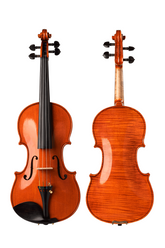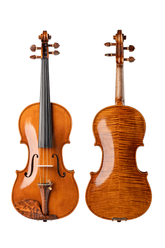America's Four Historic Music Conservatories: A Comprehensive Guide
Introduction
The Eastern Seaboard of the United States has long been the epicenter of classical music education in America. Stretching along the Atlantic coast with New York City as its cultural anchor, this region is home to four of the nation's most prestigious and historically significant music conservatories: The Curtis Institute of Music, The Juilliard School, New England Conservatory, and The Peabody Institute. These institutions have shaped generations of world-class musicians and continue to set the standard for professional music training.
What Distinguishes a Music Conservatory?
Music conservatories differ fundamentally from traditional universities. Similar to specialized arts institutions, conservatories focus intensively on music performance and composition, with minimal general education requirements. The curriculum centers on private instruction with master teachers, ensemble performance, music theory, and intensive practice—all designed to cultivate elite professional performers.
The Curtis Institute of Music
Location: Philadelphia, Pennsylvania
Founded: 1924
Student Body: Approximately 165-175 students

Image source: Wikipedia
Overview
Located in Philadelphia—America's sixth-largest city and the birthplace of the Declaration of Independence—the Curtis Institute of Music occupies a unique position in music education. Just two hours from New York City, Curtis benefits from proximity to the Philadelphia Orchestra, one of America's "Big Five" orchestras.
The Curtis Philosophy
Founded by philanthropist Mary Louise Curtis Bok, Curtis was established with a singular mission: to train exceptionally gifted young musicians to become the world's finest performers. This vision remains unchanged nearly a century later.
Admission and Financial Support
Curtis maintains one of the most selective admissions processes in higher education, accepting only enough students to form a complete orchestra—typically under 20 new students annually. Every admitted student receives a full-tuition scholarship, requiring only living expenses and minimal fees. Students majoring in piano, organ, harpsichord, conducting, or composition can rent Steinway grand pianos for merely the cost of delivery (approximately $200), retaining them until graduation.
Age and Program Structure
Most instrumental programs accept students aged 21 and under, with no minimum age requirement. This policy has created a unique campus atmosphere where musical prodigies from around the world study alongside college-age students.
Academic Programs:
- Bachelor of Music degree
- Performance Diploma
- Master of Music in Opera
- Professional Studies Certificate (voice only)
High school-age students attend local schools (ending at 3 PM) before taking lessons and classes at Curtis. Students under 16 must live with parents or guardians. Upon completing high school, students can transition to bachelor's degree candidacy.
Performance Opportunities
Curtis schedules over 100 student concerts annually, providing extensive stage experience. Advanced students can also take select courses at the University of Pennsylvania at no additional cost.
Distinguished Faculty and Leadership
Curtis has been led by legendary musicians including:
- Josef Hofmann (pianist, 1876-1957)
- Rudolf Serkin (pianist, 1903-1991)
- Gary Graffman (pianist, Lang Lang's teacher)
- Roberto Díaz (violist, current president)
Current faculty of approximately 90 includes members of the Philadelphia Orchestra and the Guarneri Quartet, alongside world-renowned soloists like Leon Fleisher and Aaron Rosand.
Notable Alumni
- Lang Lang (pianist)
- Hilary Hahn (violinist)
- Paavo Järvi (conductor)
- Lynn Harrell (cellist)
- Alan Gilbert (former New York Philharmonic Music Director)
The Juilliard School
Location: New York City (Lincoln Center)
Founded: 1905
Student Body: Approximately 800 students

Image source: Wikipedia
Overview
Situated at Lincoln Center—arguably the world's premier performing arts complex—The Juilliard School stands as America's most internationally recognized conservatory. Sharing space with the New York Philharmonic, Metropolitan Opera, and New York City Ballet, Juilliard offers unparalleled access to the performing arts world.
History and Evolution
The school began in 1905 as the Institute of Musical Arts, founded by Dr. Frank Damrosch to provide American students with European-quality training without crossing the Atlantic. In 1924, the Juilliard Graduate School was established with a bequest from textile magnate Augustus Juilliard. The institutions merged in 1926.
Key Milestones:
- 1951: Dance division established under Martha Hill
- 1968: Drama division created; school relocated to Lincoln Center
- 1983: Joseph W. Polisi becomes president, overseeing major expansion
- 2001: Jazz Studies program launched
- Present: Exchange programs with Columbia University and Barnard College
Facilities and Resources
Juilliard's infrastructure includes:
- 106 practice rooms (84 on campus, 22 in residence halls)
- Over 200 pianos
- Performance venues: Alice Tully Hall, Paul Recital Hall, Morse Hall
- On-campus student housing at Lincoln Center
Academic Programs
Degree Programs:
- Bachelor of Music
- Master of Music
- Doctor of Musical Arts
- Artist Diploma
- Graduate Diploma
- Performance Certificate
World-Class Faculty
Juilliard's faculty represents the pinnacle of performing artistry:
- Itzhak Perlman (violin)
- Cho-Liang Lin (violin)
- Oxana Yablonskaya (piano)
- Emanuel Ax (piano)
- Yoheved Kaplinsky (piano)
Historical faculty legends include Dorothy DeLay (violin pedagogue to countless virtuosos) and Josef and Rosina Lhevinne (piano).
Cost of Attendance
Annual tuition: $52,000+ (2024-25)
Total estimated cost: $80,000+ (including housing, fees, and living expenses)
Distinguished Alumni
The list of Juilliard graduates reads like a who's who of classical music:
- Yo-Yo Ma (cellist)
- Itzhak Perlman (violinist)
- Pinchas Zukerman (violinist)
- Philip Glass (composer)
- Kyung Wha Chung (violinist)
- Midori (violinist)
Surprising alumni include Alan Greenspan (former Federal Reserve Chairman, saxophone/clarinet major) and David Bryan (Bon Jovi keyboardist, piano major).
New England Conservatory
Location: Boston, Massachusetts
Founded: 1867
Student Body: Approximately 750 students

Image source: Wikipedia
Overview
Established in 1867, New England Conservatory (NEC) is the oldest independent music conservatory in the United States and the only one designated a National Historic Landmark. Located in Boston's cultural district, NEC sits just one block from Symphony Hall, home of the Boston Symphony Orchestra.
Campus and Facilities
NEC's campus comprises three buildings:
Jordan Hall Building (main facility):
- Jordan Hall concert venue (1,019 seats)
- Practice rooms
- Audio library
- Faculty studios
Student Residence:
- Cafeteria
- Library
Third Building:
- Computer music studios
- Large ensemble rehearsal spaces
- Administrative offices
Jordan Hall: An Acoustic Treasure
Cellist Yo-Yo Ma, a Boston resident, describes this century-old venue: "I love Jordan Hall's incredible acoustics, its warmth and intimacy..." The hall hosts over 600 student performances annually and is also rented to professional organizations.
Historical Significance
When the Boston Symphony Orchestra was founded in 1881, its music director recruited numerous NEC faculty as principal players—a relationship that continues today, with nearly half of BSO members being NEC faculty or alumni.
Academic Programs
NEC offers comprehensive programs from undergraduate through doctoral levels:
- Bachelor of Music
- Master of Music
- Doctor of Musical Arts
- Graduate Diploma
- Artist Diploma
Specialized majors:
- Collaborative Piano (accompaniment)
- Musicology
- Historical Performance
- Contemporary Improvisation
Academic Partnerships
- Five-year dual-degree program with Harvard University and Tufts University
- Cross-registration available with Tufts, Northeastern University, and Simmons University
- Pre-College partnership with Walnut Hill School for the Arts
Cost of Attendance
Annual tuition: $54,000+ (2024-25)
Total estimated cost: $75,000+ (including housing and living expenses)
Living in Boston
Boston offers a rich academic atmosphere with less congestion than New York City. The city features efficient public transportation and a mid-sized Chinatown. While winters can be harsh, Boston's intellectual environment and spacious layout make it an attractive alternative to New York.
The Peabody Institute
Location: Baltimore, Maryland
Founded: 1857 (classes began 1866)
Student Body: Approximately 650 students

Image source: Wikipedia
Overview
America's first music conservatory, founded by philanthropist George Peabody in 1857, Peabody Institute opened to students in 1866 following delays from the Civil War. Located in Baltimore's historic Mount Vernon neighborhood, Peabody is just one hour from Washington, D.C.
Relationship with Johns Hopkins University
In 1977, Peabody merged with Johns Hopkins University, one of the world's leading research institutions. This affiliation provides music students access to extensive liberal arts and sciences coursework while maintaining the conservatory's administrative independence.
Campus and Facilities
Peabody occupies an entire city block with multiple buildings surrounding a central courtyard garden.
Performance Venues:
- Miriam A. Friedberg Concert Hall (695 seats)
- Griswold Hall (features pipe organ)
- Two additional performance spaces
Libraries: Two specialized music libraries plus access to Johns Hopkins' extensive collections
Campus Transportation and Safety
Johns Hopkins operates shuttle buses connecting Peabody with the main campus and medical school (5-10 minutes between locations). Due to urban safety concerns, Peabody provides evening escort services from 6 PM to 2 AM. First-year students are required to live in campus housing.
Unique Programs
Recording Arts and Sciences (5-year bachelor's degree): Students master an instrument while studying physics, audio engineering, and recording technology. Students engineer all conservatory performances.
Computer Music: Another area of institutional strength
Faculty Transition and Renewal
Recent years have seen faculty transitions following the loss of legendary teachers Berl Senofsky (violin, 1926-2002) and Stephen Kates (cello, 1943-2003). Piano master Leon Fleisher continues as a beacon of 20th-century pedagogical tradition. The faculty renewal has brought fresh energy to this historic institution.
Cost of Attendance
Annual tuition: $52,000+ (2024-25)
Total estimated cost: $68,000+ (lower cost of living than NYC or Boston)
Notable Alumni
- Andre Watts (pianist)
- Philip Glass (composer)
- Tori Amos (singer-songwriter)
- Hilary Hahn (violinist, pre-college)
- Zhou Qian (violinist)
International Demographics
Approximately one-third of students are international, with significant Korean and Taiwanese populations. The nearest Asian grocery stores are 40 minutes away—prospective students should be prepared for limited Asian dining options.
Global Impact: The Singapore Connection
In 2001, Peabody partnered with the National University of Singapore to establish the Yong Siew Toh Conservatory of Music—Asia's first collaboration with a major American conservatory. Peabody faculty initially traveled to Singapore to establish curriculum and administrative structures. Former Peabody Dean of Academic Affairs Steven Baxter continues to serve as the conservatory's dean.
Conclusion
These four historic conservatories—Curtis, Juilliard, New England Conservatory, and Peabody—represent the pinnacle of music education in America. Each offers distinctive advantages:
- Curtis: Most selective, full scholarships, intimate training environment
- Juilliard: Global prestige, Lincoln Center location, multi-arts environment
- NEC: Historical significance, Boston cultural scene, strong partnerships
- Peabody: Johns Hopkins affiliation, specialized programs, global outreach
For aspiring musicians, selecting among these institutions depends on individual goals, learning style, financial considerations, and desired location. All four share an unwavering commitment to excellence and have produced generations of artists who define classical music worldwide.
Frequently Asked Questions
Q: What is the acceptance rate at these conservatories?
Curtis has the lowest acceptance rate (approximately 3-4%), followed by Juilliard (6-7%), with NEC and Peabody slightly higher but still highly selective.
Q: Can international students apply?
Yes, all four conservatories welcome international applicants and have significant international student populations.
Q: What are audition requirements?
Each conservatory has specific repertoire requirements by instrument. Auditions typically include works from different periods and may include sight-reading, scales, and etudes.
Q: Is financial aid available?
Curtis provides full tuition to all students. Juilliard, NEC, and Peabody offer merit and need-based financial aid, though full-ride scholarships are competitive.
Q: What are career prospects after graduation?
Graduates pursue careers as orchestral musicians, soloists, chamber musicians, educators, and arts administrators. Alumni networks are exceptionally strong at all four institutions.
Recommended Related Articles
Top 7 Music Conservatories in the United States for Learning the Violin





